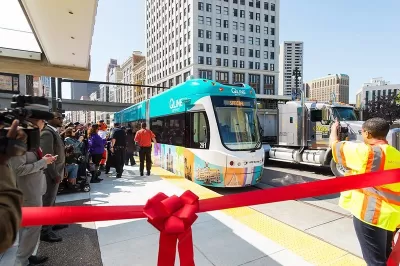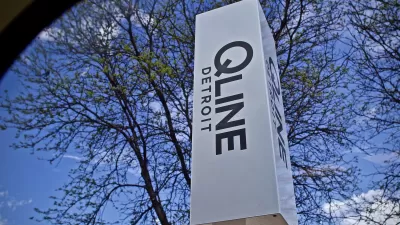The QLine could ride its own dedicated lane and serve a real need for commuters. Instead, it's a slow circulator for a small part of downtown.

Detroit's QLine was originally pitched as an attraction that would raise the value of the land around it, so those who owned that land ended up having an outsized say in its development. It was to be paid for by land owners around the route, "but they soon decided not to cover all the costs, and enlisted government support," Angie Schmitt reports for Streetsblog USA. The QLine eventually received $37 million in capital funds from U.S. DOT and another $10 million from the state of Michigan."
Despite the funding, the streetcar kept a small route a short 3.3-mile route that few have been willing to pay to ride. "It simply doesn’t serve that many people. Ridership dropped about 40 percent, to 3,000 trips per day, after the streetcar started charging a $1.50 fare in August," Angie Schmitt writes. Because it's running on a side alignment in traffic, the streetcar runs fairly slowly and can be blocked by traffic. "Public comments overwhelmingly favored the center-running approach, but 'Gilbert in particular pushed for side alignment,' according to the report, which he again believed would be better for economic development," Schmitt writes.
FULL STORY: How Detroit’s Streetcar Overlooked Real Transit Needs to Satisfy a Well-Connected Few

Planetizen Federal Action Tracker
A weekly monitor of how Trump’s orders and actions are impacting planners and planning in America.

Maui's Vacation Rental Debate Turns Ugly
Verbal attacks, misinformation campaigns and fistfights plague a high-stakes debate to convert thousands of vacation rentals into long-term housing.

Restaurant Patios Were a Pandemic Win — Why Were They so Hard to Keep?
Social distancing requirements and changes in travel patterns prompted cities to pilot new uses for street and sidewalk space. Then it got complicated.

In California Battle of Housing vs. Environment, Housing Just Won
A new state law significantly limits the power of CEQA, an environmental review law that served as a powerful tool for blocking new development.

Boulder Eliminates Parking Minimums Citywide
Officials estimate the cost of building a single underground parking space at up to $100,000.

Orange County, Florida Adopts Largest US “Sprawl Repair” Code
The ‘Orange Code’ seeks to rectify decades of sprawl-inducing, car-oriented development.
Urban Design for Planners 1: Software Tools
This six-course series explores essential urban design concepts using open source software and equips planners with the tools they need to participate fully in the urban design process.
Planning for Universal Design
Learn the tools for implementing Universal Design in planning regulations.
Heyer Gruel & Associates PA
JM Goldson LLC
Custer County Colorado
City of Camden Redevelopment Agency
City of Astoria
Transportation Research & Education Center (TREC) at Portland State University
Jefferson Parish Government
Camden Redevelopment Agency
City of Claremont




























